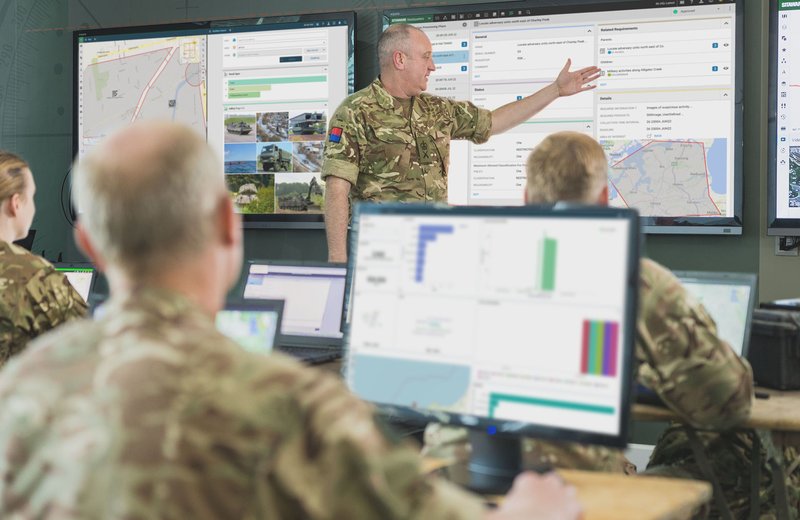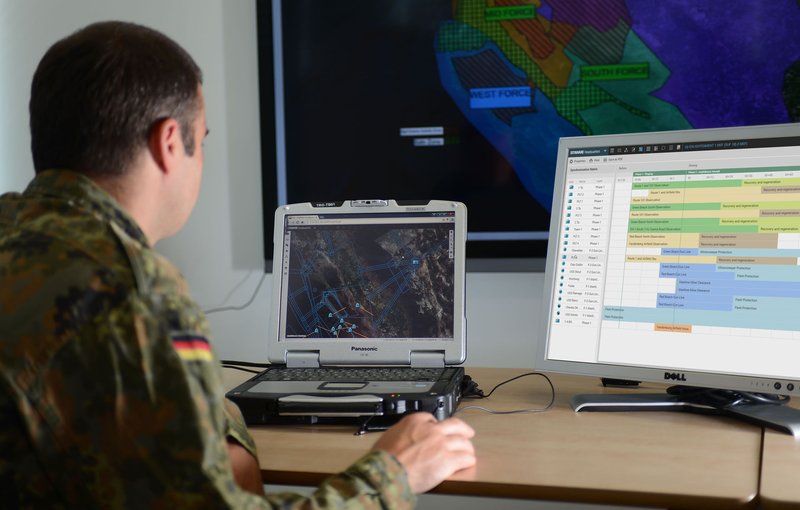Improving integration for smarter operations
This article is brought to you by Systematic
The modern command post environment is a critical decision-making centre, taking intelligence, data, and analysis products from a variety of stakeholders to ensure the smooth-running of operations. As militaries are increasing their use of multidomain approaches to undertake missions successfully, commanders need to be fully aware of all the friendly forces within an area of operations, as well as their capabilities, deployment, and operational plans, so they can best leverage their presence.
Resolving challenges that each part of a military organisation faces can ensure that plans are delivered effectively, responses co-ordinated, and units appropriately resourced. Stovepipes exist between different operations within the command environment, and breaking these silos can help deliver effects and support in a more responsive way.
Examining the intelligence cycle, the effective integration of this into the planning and operations cycles means that a military formation can operate more effectively by ensuring it has the latest information to achieve its aims.
Harmonise the planning and intelligence cycles
Within the mission command environment, the creation and distribution of plans and orders relies on inputs from a variety of actors, with intelligence being a key supporting part of ensuring that manoeuvre forces can achieve tactical success with minimal risk and gain a greater strategic success.
The role of a Commander’s Critical Intelligence Requirements (CCIR) helps to drive operations, as well as the intelligence cycle. Intelligence requirements are sent to the intelligence staff, who then seek to answer the requests using existing data available through their own data lake. If an attached intelligence staff is unable to answer the request from a commander, a Request For Information (RFI) can be sent to higher commands, adjacent or subordinate units to undertake collection tasks to complete the Recognised Intelligence Picture (RIP). The results of CCIRs are fed back into the operations plan to guide future operations.
For command staff utilising SitaWare Headquarters, SitaWare Insight provides complete management of the Intelligence Requirement Management & Collection Management (IRM & CM) processes that form the basis of the CCIR execution. Integrating these core functions of the G2/J2 staff into the planning staff’s operations allows for commanders at all levels to improve their operational effectiveness through the integration of data from assets in the field or behind the line, thereby reducing the fog of war that add to the risk factors in planning military operations.

Be at the right place, at the right time
As intelligence becomes a more integral part of operating effectively, the need to increase the use of intelligence, surveillance, and reconnaissance (ISR) has correspondingly grown. The shrinking size of sensor systems mean that units can carry more ISR equipment, sometimes with the ability to deliver this information straight into the battle management system (BMS).
This ability to position assets may not necessarily mean having to manoeuvre assets to fit a timetable or schedule. Leveraging data feeds or capabilities from existing assets that are in place can help to improve economy of effort and reduce the risk of exposure and exhaustion for other assets. Examples of this have included accessing open webcams at ports and key strategic road traffic points to identify enemy movements and deployments, leveraging AIS ship tracking technology to identify vessels and their critical information, as well as the use of open-source satellite imagery when military space-based assets are tasked on more important missions.
The use of a synchronisation matrix view in SitaWare Headquarters, in co-ordination with SitaWare Insight’s IRM & CM capabilities, allows for an overview of unit availability, capability, and inventory. This can be used to allocate collection tasks to units closest to an intelligence target – encouraging economy of movement, economy of assets, and economy of scale when gathering data.

Placing new technology at the right location
Overloading commanders and command staff with vast amounts of data streams has become increasingly possible, as the delivery of video and data feeds directly into a command post is now an expected standard. However, this means that commanders and command staff have the temptation to micro-manage from a distance or reduce the autonomy of the commander in the field.
By placing technology solutions, such as data lake access, analytics dashboards, and artificial intelligence at a variety of locations in the command chain, commanders can ensure they are receiving data that is relevant, appropriately curated, and can support their decision-making processes. SitaWare Insight employs AI and a data processing Robot to ensure that the most important information is presented to commanders, with supporting analysis staff able to navigate large quantities of data thanks to technologies such as anomaly detection, computer vision and processing, and more. Third-party AI solutions can be integrated into the workflow, allowing militaries to prioritise sorting and processing of intelligence data.
SitaWare Insight’s cloud architecture delivers a scalable solution that can be deployed in data centres as well as on a single server in theatre. This configuration also allows users to maintain full sovereign control of their intelligence system, with no data going to third-party servers.

More from Industry Spotlights
-
![“Adversaries have adapted”: how counter-UAS and space control will decide future conflicts]()
“Adversaries have adapted”: how counter-UAS and space control will decide future conflicts
In conversation... EOS's Andreas Schwer talks to Shephard's Ben Watts about how the Australian company is shifting its strategic focus to two technologies it sees as essential for success on the modern battlefield - C-UAS and space control.
-
![Tiltrotor: The Long-Range Maneuver Solution]()
Tiltrotor: The Long-Range Maneuver Solution
If competition turns to conflict, the United States, along with its allies and partners, must be prepared to confront peer and near-peer competitors capable of achieving parity in military capability.
-
![Introducing the MITR-M1 Half Mask: Tactical respiratory protection for every scenario]()
Introducing the MITR-M1 Half Mask: Tactical respiratory protection for every scenario
Counter terrorism, specialist firearms officers, special forces, explosive breaching, drug interdiction, riot control, indoor/outdoor shooting, environmental disaster response, first response, prisons and corrections: tactical operators across law enforcement, first responders, and the military face a vast array of low-mid level respiratory threats in their day-to-day operations.
-
![Need to develop AI-powered red pictures for battlefield situational awareness?]()
Need to develop AI-powered red pictures for battlefield situational awareness?
Leverage Systematic's SitaWare suite to fuse intelligence and share awareness of your opponent’s deployments and capabilities.
-
![Sustain capabilities and secure advantage with advanced Digital Engineering]()
Sustain capabilities and secure advantage with advanced Digital Engineering
CDS Defence & Security optimises defence systems with Digital Engineering and MBPS for peak performance. Learn more today!
-
![Solving production & supply chain challenges with additive manufacturing]()
Solving production & supply chain challenges with additive manufacturing
Boosting supply chain resilience with additive manufacturing: exploring solutions to production and logistics challenges.


























